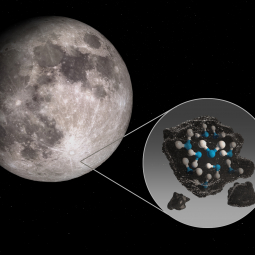By Casey Honniball, Paul Lucey, and Joan Schmelz
Paper:
Molecular water detected on the sunlit Moon by SOFIA
C.I. Honniball, et al., Nature Astronomy 2020.
Researchers using SOFIA have made the first-ever detection of the water molecule (H 2 O) on the sunlit surface of the Moon. This discovery refines our understanding of the behavior of water and how volatile elements and compounds interact with airless bodies throughout the Solar System and beyond.
Water and other volatiles can influence the internal processes and surface expression of planets. Water suppresses the melting point of rock, promoting volcanism, and reduces the viscosity of planetary interiors, enabling more efficient internal circulation and heat transfer. Water and other volatiles tend to concentrate on planetary surfaces, creating atmospheres, hydrospheres, and cryospheres, and can even dominate the surface geology.
The Moon likely formed in a giant impact, stripping it of its initial volatile inventory and allowing it to begin as a "blank slate" for volatiles. This made the Moon a natural laboratory for the study of volatile elements and compounds added later in Solar System history. The hydrogen-rich solar wind and water-bearing meteorites are thought to be the principle conveyors of water to planetary surfaces, but their relative contributions as well as the space-surface chemistry interactions are poorly known.
Water has been detected previously in trace amounts in the lunar exosphere and in sparse occurrences as ice in permanent shadow at the lunar poles, but the possible pathways of water through the lunar environment are poorly understood. For decades, laboratory studies have shown that water's cousin, hydroxyl (OH-), can form from the hydrogen in the solar wind and oxygen in lunar minerals. Lunar hydroxyl has been detected remotely in reflectance spectra at 3 µm by spacecraft.
Recent laboratory experiments have shown that it is possible to form H 2 O vapor from hydrogen irradiation by adding the energy simulating a meteorite impact. Studies have also shown that water from meteorites can be trapped in the glass formed during the impact. But H 2 O has never been detected directly on the sunlit lunar surface. In fact, the H 2 O and OH signals are blended at 3 µm, so these spacecraft observations cannot separate water from drain cleaner. Direct detection of water on the Moon had, therefore, eluded scientists, and new methods were needed to continue the search.
The unambiguous water detection was made possible by SOFIA’s unique capabilities and the sensitivity of the FORCAST spectrometer. The fundamental bending vibration of the H-O-H molecular bond occurs at 6.1 µm in the infrared. This region of the spectrum is completely obscured from the ground by water in the Earth's atmosphere, but is highly transparent from SOFIA's operational altitude in the stratosphere. In addition, the spectral feature at 6.1 µm is unique to H 2 O and does not suffer from blending from other OH-related compounds.
SOFIA targeted high lunar latitudes near the South Pole, where the low temperatures could allow migrating water to transiently remain on the surface, and the high hydroxyl abundances could promote creation and trapping of water by impacts of small meteorites. Comparing the 6.1 µm emission band intensity to those of carefully calibrated water-bearing glasses, the team found water abundances of a few hundred parts per million. It is the extreme sensitivity of SOFIA that allowed scientists to detect this miniscule amount of water, which is 100 times less than that in the Sahara Desert.
But even this amount of water is high by lunar standards, more in fact than can be adsorbed on lunar grains at the surface temperatures recorded by SOFIA. This result indicates that much of the water must be trapped in impact glasses or within/between grains sheltered from sunlight. These results indicate that the water has a meteoritic origin or is produced on the lunar surface itself from pre-existing hydroxyl. The team also found that the abundance of water varies with latitude, suggesting that meteorites may not be the only source of water.
Further observations with SOFIA will create water maps of the nearside lunar surface and gather evidence supporting theories of the origin of lunar water. Observations covering large areas obtained at various times of the lunar day will enable scientists to learn about the storage, retention, and migration of water on the surface of the Moon. Studying lunar water remotely with SOFIA is critical for future NASA missions, including the VIPER lunar rover, a mobile robot that will explore the landscape near the moon’s South Pole in 2022, and the Artemis program that will return humans to the moon by 2024.
